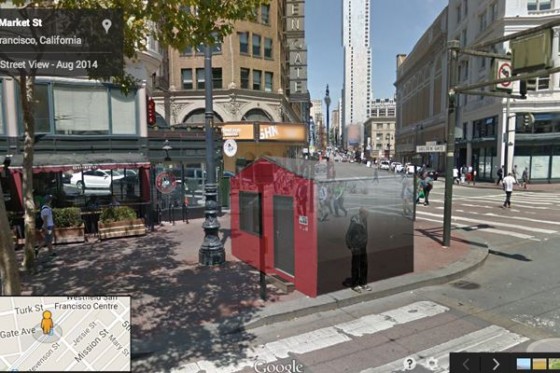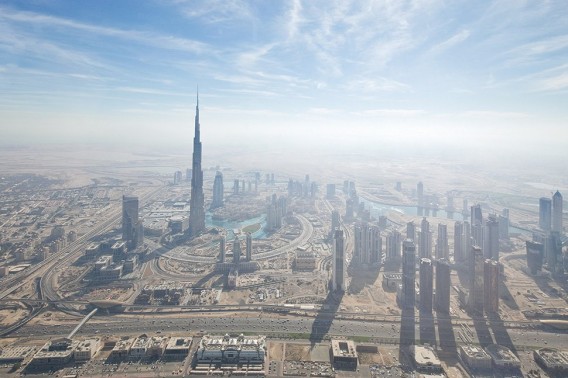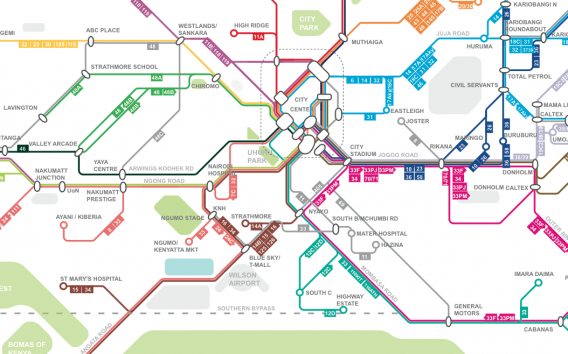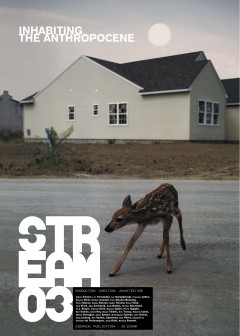














March 19, 2015 | permalink

(Published at Next City on March 19, 2015.)
Next month, the 250,000 daily travelers along Market Street – San Francisco’s three-mile-long central artery – will discover some new attractions along their commutes. Near the Embarcadero, a metal wall six feet tall and eight feet long will chime when touched or tapped. In the Financial District, “Data Lanterns” will draw on transit and other public data feeds to glow in response to arriving trains. A little further down the street, near the city’s Civic Center, billowing sheets of fabric will evoke a more tactile version of fog, while a street theater with seats made of compacted mushrooms will be composted after use.
These are just four of the fifty finalists in the Market Street Prototyping Festival, a novel effort to engage local designers, artists, and residents of surrounding neighborhoods in the remaking of thirty-six blocks of Market Street ahead of its planned reconstruction in 2018. For three days in April, the public will play-test their projects, offering feedback that will be used to select concepts to include in the final design.
The festival is also a prototype in its own right for a Bay Area strain of tactical urbanism that neither originates purely from above (a la the stealth makeover of Times Square in New York) or below (e.g. painting your own bike lanes), but tries to occupy middle ground. In this iteration of tactical urbanism, city planners commission ideas from citizens, iterate their designs with the help of community and professional partners, and incorporate their creations into official plans. The festival’s backers hope the process can become a model for other cities.
March 19, 2015 | permalink

“I have 6,000 contacts. Which ones should I be talking to?” asks Andy Wilson, co-founder and CEO of Pasadena, California-based startup Rexter. “It used to be answered by intuition, but intuition doesn’t scale.” Rexter’s answer is to plug into users’ social media profiles, Microsoft Exchange servers, and phone conversations and start listening. There, running silently, it reads emails, logs chats, and keeps tabs on calendars. Once you program Rexter with stated objectives—find new hires; raise more funding—algorithms that analyze the quality and freÂquency of your communications hunt for patterns buried in your exchanges with connections and suggest whom you should contact. Who’s relevant to your latest deal—and when were you last in touch? Who on your team has an in with a potentially valuable target?
Rexter—which costs $30 for individuals and $50 per interlinked user in group settings—also gathers formidable intel on your operations. “This gives you a deep dive into what [employees] actually do,” says Ted Simpson, a Los Angeles-based managing director of real-estate firm Avison Young. “Are they spending too much time cold-calling instead of relationship-building?” He describes Rexter as “the missing link between Salesforce.com, Outlook, and your Rolodex.”
That’s the newest sweet spot in the $20 billion-plus customer relationship management market, in which Salesforce tracks pending transactions, LinkedIn traces whom you know and how, and group-chat programs such as Asana and Slack seek to replace email as the best way to follow tasks and conversations. If those are partial maps of how work gets done and by whom, Rexter aspires to be Waze, and offer turn-by-turn directions to accomplish specific tasks.
Wilson was inspired to start Rexter after struggling to manage relationships as he helped launch more than a dozen startups as a founder and director of Momentum Venture Management, a Los Angeles tech accelerator. No tool could handle the pace and scale of tackling his many tasks, he recalls: “There was simply no good way to manage your social network for the benefit of a team.” In 2010 he set out to invent one, and he’s since raised $2.3 million from such angel investors as the former CEOs of Ticketmaster and paid search pioneer Overture. Today, Rexter’s competitors include RelateIQ—which was bought by Salesforce last year for $390 million—and Humin, a new app that adds context to your contacts list.
One seductive possibility for entire businesses using Rexter: comparing outcomes (deals closed, products launched) with the flurries of messages preceding them, revealing successful strategies that can be copied. That’s what Mark Madigan hopes. He’s the national sales director of the privately held insurance firm Risk Strategies. “We have very high hit rates when we get in front of clients or prospects,” he says. “But our struggle is getting enough meetings. How do we get more?” Rexter, he believes, will help.
Wilson readily admits that, within groups, the intelligence his software collects could be abused, but stresses there are protections in place to prevent managers and teammates from, say, reading others’ email. He’s hopeful customers will choose enlightened self-interest over undermining internal competitors. “In organizations where you eat what you kill,” he says, “we can help you kill more.”
March 19, 2015 | permalink
If you’re still pondering whether to head to Silicon Valley for your next startup, you’re not thinking big enough or far enough. Over the coming decade, the 600 largest and best-connected cities on the planet will contain a fifth of the world’s population, capture almost two-thirds of its economic growth, and encompass more than half of global GDP, according to the McKinsey Global Institute. And, as great as the Bay Area and Boulder and Austin are for launching a startup, you’d be only scratching the surface here when it comes to corralling talent, tapping the world’s next big market (hint: they speak Arabic), or being present for the next tech breakthrough.
America’s entrepreneurial spirit is too big to be contained by borders. Here, we present five global alternatives to traditional hotbeds of startup creation and growth. Each city offers unique advantages to American entrepreneurs, and each is a regional—or even global—hub in its own right. Some are great places to launch a business or expand into new markets. Others offer access to expertise or technologies that may not yet be available in the U.S. Many are home to some of the world’s best workers, as well as to partners who will help you scale.
For example, Istanbul and Dubai are gateways to the modern Middle East, a market that is growing faster than (and is younger and bigger than) that of the United States. Santiago, Chile, has made a name for itself as one of the most foreign-entrepreneur-friendly cities on the planet, and as a test bed for launching into Latin America. Tallinn, Estonia, is one of the world’s most internet-connected cities, with a deep pool of technical talent thanks to all the Skype alumni running around. Shenzhen, China, aspires to be the Silicon Valley for hardware makers, a place where accelerators are eager to help you build, test, refine, and make a million of something all in the same day. If these cities aren’t already on your radar as lands of opportunity for your company, let this serve as notice that they should be.

1. Gateway to a Megamarket
DUBAI • UNITED ARAB EMIRATES
Population • 2.1 million
Most famous startup • Souq.com
Only the kingdom of bling would kick off a recruiting drive for entrepreneurs with a $1.5 billion “innovation hub.” Announced last fall, this mammoth expansion of Dubai’s Internet City is poised to be the launchpad for a new generation of Arab-owned companies looking to partner with the emirate’s deep-pocketed conglomerates and to expand across the entire region.
Widely written off after the global financial crisis, Dubai has lost none of its swagger—and none of the advantages that made it the region’s best business hub. Entrepreneurs willing to endure scorching summers, punishingly high housing costs, and a dearth of local tech talent are able to exploit the emirate’s unmatched investments in infrastructure, low taxes, and tolerance for expatriates. It’s one of the world’s “few truly connected global cities,” according to the McKinsey Global Institute, and one that’s a crossroads for North Africa and the Middle East.
Dubai’s monarchy can also think like a startup when it wants to. The inaugural U.A.E. Drones for Good competition awarded more than $1 million in prizes in February as part of an effort to seed the Middle East’s drone industry, with more than a dozen such startups launching in the emirate. A similar initiative, the U.A.E. 3-D Printing Innovation Alliance, brings together local universities, 3-D-printer companies, and regional entrepreneurs in an attempt to cement Dubai’s status as the leader in an industry that’s still searching for its killer app.
January 25, 2015 | permalink

(Originally published at Next City on January 21, 2015.)
Last month, on a blustery night the week before Christmas, my friend Jeff Ferzoco and I sat alone in a gay club in Brooklyn’s Williamsburg neighborhood discussing Grindr, the mobile dating app used daily by five million gay men around the world. We’d arrived at the bar too early, he assured me. By the end of the night, he said, “it will be so crowded people will be using it just to see who’s in the room.”
I believed him, because earlier that year I had seen Jeff navigate the social terrain of Manhattan’s East Village this way. Ferzoco is a designer, the former creative director of New York’s Regional Plan Association, and the author of The You-City, which envisions a smart city five minutes into the future. As such, he’s someone who thinks a lot about how our phones are changing our relationship with public space. Instead of using Grindr (or his preferred alternative, Scruff) to meet men from the comfort of his couch, he keeps tabs on his friends who are already out to decide when and where to join them.
Walking up 2nd Ave. that night in August, Ferzoco had held his phone before him like a compass, checking to see whether we were getting closer to his friends or moving farther away. Scruff, like Grindr, reveals other users’ proximity as the crow flies, but doesn’t disclose their exact location – at least not intentionally. He had mentally mapped the app’s generic distances onto the Manhattan grid (“Two-hundred-and-fifty feet is about a block-and-half,” he said) and could reference his location against a list of their usual haunts. On that night, he found them at a bar called Nowhere.
For all the handwringing about “hookup” apps undermining monogamy, fewer have wondered how their use of proximity to serve up potential matches is changing users’ perceptions of the city. Based on sheer numbers and intensity, they must be. Grindr’s rise was a watershed in a cruising culture that had always relied on coded signals and assignations in public space. Today, 38 million messages are exchanged daily through the app, many in countries where homosexuality is a capital crime.
Many observers doubted whether Grindr’s meat market would translate to straight dating until Tinder’s arrival. The notoriously addictive app has been downloaded more than 40 million times in less than three years and at last count was making 14 million matches daily. Depending on who you ask, it’s worth somewhere between $500 million and $5 billion to its parent, IAC.
January 18, 2015 | permalink
On December 9, 2014, I hosted “Influx and Exodus: Two Conversations on Urban Density,” an event hosted by the Van Alen Institute and co-sponsored by the World Policy Institute. In a pair of back-to-back panels, we explored how Rust Belt cities are struggling to repurpose vacant land and adapt the delivery of fundamental services, while cities like Mumbai and Lagos sprawl ever outward with dense informal communities. In both cases, adapting to sudden population change presents a massive challenge. How can city infrastructure and policy keep pace with the dramatic shifts brought on by rapid growth and decline?
The video above is from the second panel dealing with the challenges of immigration and mega-urbanization. I was joined by Janice Perlman, Founder & President of the Mega-Cities Project; and Rachel Peric, deputy director of Welcoming America. Please enjoy.
December 29, 2014 | permalink

(Global Solution Networks, a research initiative of the Martin Prosperity Institute at the University of Toronto, in collaboration with The Tapscott Group – an international think tank headed by Don Tapscott – asked me to prepare a report on new approaches to urban mobility in an era of mega-urbanization, economic austerity, and climate change. The introduction to the report is below; the complete report is available for download at the GSN Website.)
Introduction
Catalyzing urban mobility in an era of mega-urbanization, economic austerity, and climate change demands new approaches to transportation planning and policy, especially in the megacities of the Global South. Tackling traffic congestion in such cities as Nairobi, Manila, Delhi, and Mexico City is essential to reducing carbon emissions while increasing the scope of inhabitants’ opportunities and quality-of-life.
Tackling traffic problems will require marshaling untapped resources and recruiting unlikely allies. Conventional transportation planning by public- and private-sector actors alike ignore the informal transportation networks ferrying millions of commuters daily, whether they’re dollar vans in New York or matatus in Nairobi. New technologies and services will play a pivotal role in discovering, integrating, and delivering more inclusive, more fluid, and less polluting transportation networks comprising existing modes, from metros and bus rapid transit (BRT) to rickshaws and unlicensed jitneys.
In this context, Global Solution Networks are emerging around what has been called the “new mobility” – a shift away from private motor vehicles toward multi-modal networks mediated by information. Some of these networks are generating and safeguarding the new data standards and protocols enabling these networks; others are introducing and lobbying for more sustainable and more equitable transportation policies around such networks; and still others are delivering services that are neither traditional public transit nor private operators, but a more resilient hybrid.
Hot, Broke, and Gridlocked
Mobility and congestion have become paramount issues for cities facing an unprecedented wave of rural-to-urban migration. More than half the world’s population – 3.5 billion people – now live in cities, and their numbers are expected to nearly double by 2050 at a rate of more than a million migrants weekly.
An enormous quantity of infrastructure is required to house, employ, and transport these new arrivals – an estimated $350 trillion worth, of which $84 trillion should be earmarked for moving people and goods. Arguably, transportation is the most important investment cities can make, given its impact on land use, labor mobility, energy consumption, and air pollution, all of which in turn have profound implications for both accessibility and sustainability.
The speed and scale of mega-urbanization – and with it, epic traffic congestion and its accompanying climate impact – has overwhelmed policymakers. They struggle to understand new patterns of informal transit, are unable to finance large investments due to austerity, and have largely been unable to reach consensus on how to integrate existing investments into a more coherent mobility system.
December 18, 2014 | permalink

(On December 9, 2014, I moderated a pair of back-to-back panels at the Van Alen Institute on “Influx and Exodus: Two Conversations on Urban Density.” The following description by Jas Singh was published by the World Policy Institute, which co-sponsored the event.)
From Sao Paulo to Lagos, the increasing globalization of the market economy in the 21st century has catalyzed existing rural-to-urban population migration trends. With an estimated forecast of three-quarters of the world’s population living in cities by 2050, this demographic pattern will become more and more prevalent. By contrast, legacy cities of the American Rust Belt are suffering the effects of urban decay as a result of a shrinking industrial sector and declining populations.
In both cases, there are potentially crucial lessons to be gleaned about the social, economic, and political consequences of such dramatic population shifts. To this end, in partnership with the Van Alen Institute, the World Policy Institute hosted “Influx and Exodus: Two Conversations on Urban Density.” In back-to-back panel discussions, the central concern was how city infrastructure and policy can be designed to keep pace with the demographic shifts that accompany rapid economic growth and decline.
Greg Lindsay, a senior fellow at World Policy Institute and a director of its Emergent Cities Project, moderated both discussions. The first part “Exodus,” featured Alan Mallach, senior fellow at Center for Community Progress; Nadine Maleh, a director at Inspiring Places; and Nick Hamilton, a project manager at the American Assembly and head of the Legacy Cities Partnership. The panelists discussed the best methods for repurposing aging infrastructure and adapting the delivery of fundamental services to the residents living in legacy cities.
Mallach began by focusing on urban planning strategies to tackle the inherent problem of the physical environment that all ailing cities face: a surplus of buildings and ground relative to demand. The simplest and most cost-effective of these was instituted by the Pennsylvania Horticultural Society through the Land Care Program, which resolved the problem of empty lots becoming dumping grounds by planting grass and trees and installing a simple split rail fence. On the other end of the spectrum, in a far more sophisticated approach, Baltimore used a triage strategy to identify the areas of the city that would generate the greatest social and economic benefits from demolition, housing rehabilitation, and real estate development.
Maleh then discussed the importance of a decentralized approach to real estate design in case studies of Brownsville, NY and Northeast Hartford, Connecticut. Both of these communities can be described as “urban-rural,” as they are urban in fabric but rural in their disconnection from city centers and city resources. Maleh stressed that it is critical to activate resident engagement in the cities’ revitalization efforts as the residents’ needs have evolved considerably over the lifetime of the cities.
Despite their fiscal downturns, Hamilton stressed legacy cities should be viewed as assets given that the aggregate of fifty legacy cities in the United States have a metropolitan economy of $2.6 trillion–larger than that of France. However, given the cities’ limited resources in unlocking their own economic potential, it is important that investments be carefully targeted and clustered to generate the greatest return. Further, multiple actors need to be involved in this effort, from metropolitan areas to the federal government.
In the second part of the discussion, “Influx,” a new panel featured Janice Perlman, founder and president of the Megacities Project and Rachel Peric, deputy director of Welcoming America. The panelists addressed the policies that cities should adopt to adapt to the needs of burgeoning populations.
Perlman emphasized that the consumption and production power of the people living in the world’s informal settlements, whether in Asia, Africa, or Latin America, should not be written off. While currently one billion people live in such settlements without access to urban and social services, this number is projected to increase three-fold by 2050, when one in three people on the planet will be living in settlements unregulated by governments. The magnitude of the social impact of this fact cannot be understated, since 1.4 million people across the world, but especially in the global south, immigrate from rural to urban settings every week.
She further argues that existing programs to address the needs of the informal sector are fraught with problems, because they are not sufficiently localized. Place-based solutions, including 18 national programs, sponsored by the World Bank and UN Habitat, aim to upgrade urban infrastructure without any input from residents and with no mention of social or human services. Frequently, these programs fall behind schedule, exceed budget capacity, and are eventually replaced entirely by bulldozing people’s homes and moving them to public housing, where conditions are usually far worse. Poverty-based solutions, such as conditional cash transfers sponsored by the governments of Mexico and Brazil, are not balanced with purchasing power parity and therefore provide only marginal benefit to urban populations.
In 1988, Perlman founded the Mega-cities Project to advocate an alternative approach to urban reform, one that is youth-led and makes cities youth-participatory. This approach favors scalable, replicable grassroots programming that is supportive of community-based knowledge and expertise. Communities are allowed to decide for themselves what urban reform should mean.
Peric capped the discussion on the domestic front with a focus on how U.S. cities can make themselves more open, inclusive, and welcoming to immigrants in order to revitalize their economies. Citing the example of Nashville, Tennessee, Peric argued that in order to foster a climate of inclusion, cities should implement programming that not only helps new immigrants adapt to new communities but also helps communities adapt to new immigrants. To this end, engagement with local leaders is critical for communities to understand that accepting an influx of immigrants is not only morally imperative but also economically pragmatic.
December 08, 2014 | permalink

I’m honored to be included among the subjects interviewed in Stream 3, a biennial doorstop of a magazine published by PCA Architects’ founder Philippe Chiambretta (who also hosted my interview with Hans Ulrich Obrist at this summer’s Venice Architecture Biennale). A link to the full PDF of my interview is below; here’s the introduction:
Greg Lindsay explores the financialization of urban planning since the beginning of the twenty-first century, which is normalizing architecture and has driven him to take interest in the informal forms of urban growth. Running counter to the new, overly technological, urban utopias, he feels that our future resides in what calls “smart slums,” an intermediate form composed of informal and negotiated spaces. Thanks to digital technologies, they are made porous and adaptable in a dynamic process which enables them to maintain the intensity that is the real source of wealth in cities. Considering that the form of cities is shaped by transportation, he also delves into the concept of the “aerotropolis:” new cities shaped by and created for air transport, which he describes as the embodiment of globalization.
December 01, 2014 | permalink
(Britain’s Royal Geographic Society interviewed me for the October issue of its magazine, Geographical. While accurate, the editing of the interview was a bit, um, aggressive. That said, it was an honor to join more deserving figures such as Naomi Klein and David Harvey in the series.
Boris Johnson’s plans to start again with the Thames Estuary Airport scheme are problematic. The Thames Valley area is completely integrated into the global economy. If Johnson’s plans went ahead all those firms would be stripped out. What proponents of the plan hope would happen is that these businesses would move to another area in the UK, but that is fantasy. Businesses would say, ‘Forget it. We’re going to Schipol Airport.’
There is an expectation that in the next 40 years we’re going to have mega globalisation, with increased migration from rural to urban areas. Cities will be in trouble because birth rates will decline. We may be about to see the final global system because soon we will have built all the cities ever needed. The question then becomes how cities will jockey for position.
Air routes reflect this city hierarchy in action. Frankfurt is a perfect example. It’s not the largest city in Germany; it has never been the capital, but it has become Europe’s financial centre. India’s new prime minister, Narendra Modi, wants to build an urbanised corridor through the country, and airports are a key part of that strategy. Western China needs airports to be joined to the global supply chain. Zhengzhou now has one of the largest airports under construction because that’s where Foxconn has moved iPhone assembly.
There will not be a global capital of 2040 in the way we think of New York in the 1920s. China’s cities will play a larger role than India’s because of its autocratic nature and commercial resources. India still contains both Californian and Afghani levels of wealth and poverty.
What holds Dubai back are a number of problems: the local interpretation of Islam means there’s a limit to the tolerance level in the city; there’s also censorship and the fact Dubai does not offer long-term visas. The city also suffered from the global financial crisis. If Dubai did it right, the city would give away all the unused office space to start ups that want to relocate there. Dubai is the creation of the US and Europe. After 9/11, Europe and the US started to close the borders. If you were a talented Algerian you did not have a chance to go to US or the EU, so where did you end up? You went to Dubai.
There are many cities like Tokyo, which grew slums from scratch after earthquakes in the 1920s. People built slums, but what happened there – and what’s happening now in Brazil – is that these slums became middle class cities. Researchers in Mumbai asked people in areas considered slums, ‘Do you live in a slum?’ People always said, ‘No, the slum is somewhere else. It’s not where we are.’ I used to favour more planning in cities, but now I prefer a more informal approach. There will not be enough time to plan all the cities required. At the Emerging and Sustainable Cities Initiative we try to learn from emerging cities like Mumbai; we think ideas about creating an upwardly mobile slum could be applied to places like Detroit. This is a city with 40,000 empty buildings because of regulation and foreclosures.
Detroit is an example of how the divide between the developing and the developed world has collapsed. In Detroit there’s a group called the Detroit Water Brigade who provide water to residents cut off from the water system. There is an injustice because there are golf courses with water left on to water grass, while ordinary residents cannot get water. The best expert on informal water distribution is the largest NGO in Kabira [a slum in Nairobi], and that is where the people of Detroit turned for help. US cities have slum dynamics because of austerity.
I love New York. I also love Dubai. It’s not a melting pot because the city is very stratified. This is a place where the notion of a ‘city’ is a totally globally dispersed people. Dubai is filled with Indian businessmen and African traders; it’s the new Silk Road.
Detroit is a nightmare city because it is a bizarre alternate version of New York. Detroit’s Michigan Central Station was built by the same architects who built Grand Central Station in New York, but the former was derelict for years. If Detroit carries on its current trajectory, the US will be remembered for creating one of the world’s greatest cities and then destroying it. The poor are being forced out of the inner cities and the suburbs are becoming the centre for marginal groups. This is a new urban crisis where the challenge is to address problems in suburban areas that have nothing in common with inner cities.
November 17, 2014 | permalink
I was incredibly honored and flattered to be asked by the Municipal Art Society’s Mary Rowe to deliver the keynote address at last month’s annual Jane Jacobs Forum. (I’d like to think Jane would have approved, but can’t be sure). The video is above – I manage to squeeze a lot into six minutes.

» Folllow me on Twitter.
» Email me.
» See upcoming events.

Greg Lindsay is a generalist, urbanist, futurist, and speaker. He is a non-resident senior fellow of the Arizona State University Threatcasting Lab, a non-resident senior fellow of MIT’s Future Urban Collectives Lab, and a non-resident senior fellow of the Atlantic Council’s Scowcroft Strategy Initiative. He was the founding chief communications officer of Climate Alpha and remains a senior advisor. Previously, he was an urban tech fellow at Cornell Tech’s Jacobs Institute, where he explored the implications of AI and augmented reality at urban scale.

----- | January 22, 2024
The Future of Generative AI in Architecture, Engineering, and Construction
----- | January 1, 2024
----- | August 3, 2023
CityLab | June 12, 2023
Augmented Reality Is Coming for Cities
CityLab | April 25, 2023
The Line Is Blurring Between Remote Workers and Tourists
CityLab | December 7, 2021
The Dark Side of 15-Minute Grocery Delivery
Fast Company | June 2021
Why the Great Lakes need to be the center of our climate strategy
Fast Company | March 2020
How to design a smart city that’s built on empowerment–not corporate surveillance
URBAN-X | December 2019
CityLab | December 10, 2018
The State of Play: Connected Mobility in San Francisco, Boston, and Detroit
Harvard Business Review | September 24, 2018
Why Companies Are Creating Their Own Coworking Spaces
CityLab | July 2018
The State of Play: Connected Mobility + U.S. Cities
Medium | May 1, 2017
Fast Company | January 19, 2017
The Collaboration Software That’s Rejuvenating The Young Global Leaders Of Davos
The Guardian | January 13, 2017
What If Uber Kills Public Transport Instead of Cars
Backchannel | January 4, 2017
The Office of the Future Is… an Office
New Cities Foundation | October 2016
Now Arriving: A Connected Mobility Roadmap for Public Transport
Inc. | October 2016
Why Every Business Should Start in a Co-Working Space
Popular Mechanics | May 11, 2016
Can the World’s Worst Traffic Problem Be Solved?
The New Republic | January/February 2016

January 31, 2024
Unfrozen: Domo Arigatou, “Mike 2.0”
January 22, 2024
The Future of Generative AI in Architecture, Engineering, and Construction
January 18, 2024
The Promise and Perils of the Augmented City
January 13, 2024